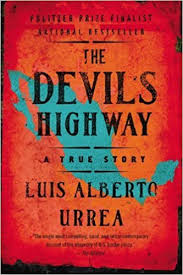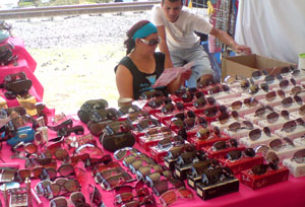 This is the story of a group of men who have become known as the Yuma 14. They are the fourteen illegal immigrants who died attempting to cross the Arizona border in May, 2001. And what a terrible and upsetting story it is. Unknown numbers of these illegal immigrants die every year making the dangerous crossing on foot over one of the most inhospitable stretches of terrain in the world. But the Yuma 14 constituted the largest known number of such immigrants to die at one time.
This is the story of a group of men who have become known as the Yuma 14. They are the fourteen illegal immigrants who died attempting to cross the Arizona border in May, 2001. And what a terrible and upsetting story it is. Unknown numbers of these illegal immigrants die every year making the dangerous crossing on foot over one of the most inhospitable stretches of terrain in the world. But the Yuma 14 constituted the largest known number of such immigrants to die at one time.
Urrea uses this incident as the moving force of his story, and it’s a compelling tale. As he tells, it the deaths of these fourteen men say a great deal about the overall picture involving illegal immigrants. He has done his research thoroughly and has interviewed Border Patrol officers, coyotes (the men who lead the immigrants over the border), politicians on both sides of the border, people and groups who favor opening the border and those who would slam it shut, as well as the immigrants themselves.
We also meet men like Don Moi a fixer in the state of Veracruz who acts as a recruiter of locals who want to go to the U.S. He arranges loans for these men – after all, it can cost as much as 13,000 pesos just to join a party heading north. That’s like a year’s pay to a typical immigrant who usually has to put up his meager plot of land to local loan sharks. Don Moi, the fixer, takes his cut. He does very well for himself. After all, thousands of such desperate men have left Veracruz to try their luck in the U.S. When he has recruited a large enough group he then arranges a bus to take the party the 2,000 miles north to the point where they will link up with the coyotes and start walking to the Arizona border.
The men who died were well within the border. In their case they were led by a new coyote who became lost in the desert. He was a nineteen year old from Guadalajara. He had two associates and, if he hadn’t killed his clients, the trio would have shared three thousand dollars for their efforts. It’s easy to become disoriented in the rugged terrain. The Devil’s Highway doesn’t have signposts and beaten paths or any other aids to navigation. When the group ran out of water, the coyote set off up north to get help and never came back. The group, in even greater weakened condition waited and then set off north themselves. Out of twenty six in the party, only twelve made it to safety.
The terrain which the immigrants had to cross sounds like a version of hell. Ground temperatures soar as high as 130 degrees on sunny days and some nights drop only as low as 98 degrees. The area is isolated enough that some car radios can’t pick up a signal on either AM or FM. It has its share of wildlife, most of it nocturnal and poisonous – sidewinders, scorpions, rattlesnakes, black widows, tarantulas, snakes, gila monsters, even killer bees.
A place like Sasabe, which is located immediately on the Sonora/Arizona border, seems to exist solely as a jumping off point for walkers. Hundreds of walkers leave from there heading due north each day. The border in that area is no more than a wire fence that stretches roughly from Yuma to Nogales. In some places the fence doesn’t even exist. It would seem, too, that the border is perhaps better patrolled in the neighboring states – New Mexico and California.
Water is a constant problem. The immigrants always have to make sure they carry sufficient quantities. Getting lost and not having sufficient water for the time they took finding the right route contributed enormously to the deaths of the fourteen victims. There are many occasions when walkers have to resort to drinking urine – their own or that of someone else. As Urrea reports, train crews traveling through the area have learned to carry stores of bottled water to drop out of their locomotives at the feet of staggering illegals.
Urrea tells the story of the fourteen victims in a compelling fashion, even giving brief sketches of each individual. They were mostly workers on coffee plantations or farmers. They were all leaving family situations – new brides, a wife and several children or a girlfriend they wanted to marry someday. They usually had specific aims, like raising enough money to buy furniture or to build a house, or, in one case, to put a new roof on a mother’s house. All of them simply wanted a better life and saw the chance for that in the U.S. The research is quite complete. Urrea even tells us exactly how much each man paid Don Moi to join the group.
To read these stories simply makes one damned angry, especially with the coyotes and the fixers and all the scumbags who prey on people who are at the absolute bottom of the economic and social pyramid and whose only goal is to find a better life for themselves and their children – in short, people who can least afford to be ripped off.
But there’s much more to this story than the events surrounding the deaths of the fourteen men in May 2001. Urrea also tells us about the activities of the Border Patrol and the various politicians on both sides of the border – those who favor immigration and those who would like to build a very high wall from one end of the border to the other. He’s interviewed them all.
There are really two books here. One is the human story of the fourteen men who died. The other covers all the aspects of maintaining and patrolling and trying to control the activity at the border, along with the politics involved. Urrea has done a wonderful job of blending the two stories and telling them in a colorful, slightly slangy but highly readable prose.
I was particularly taken with one of the final chapters which is concerned the pros and cons of the economics of the Mexican invasion. Here are a few random numbers:
Each illegal immigrant who makes the crossing costs the State of Arizona $55,200 in welfare, medical services, school services, various outreaches over a lifetime of menial labor.
Mexican immigrants paid nearly $600 million in federal taxes and sales taxes in 2002.
Mexican immigrants use about $250 million in social services such as Medicaid and food stamps and another $31 million in uncompensated health care. That leaves a profit of $319 million.
The total buying power of Arizona’s Mexican immigrants is estimated at $4.18 billion. The state’s Mexican immigrants spend an estimated $1.5 billion in mortgage payments and rents annually.
Arizona gets $8 billion in economic impact annually from the relationship with Mexico. And so on…. There are many more such statistics.
In my humble O: Luis Alberto Urrea is to be congratulated on a fine achievement in researching and writing this book. If the topic holds any interest for you this is the one to read.
The Devil’s Highway – A True Story
By Luis Alberto Urrea
Back Bay Books. 2004
Available from Amazon Books: Paperback


On the USA side of the border, Arizona neighbors California and New Mexico, NOT Texas.
Thank you for pointing out that error which has now been corrected. Saludos, TB.